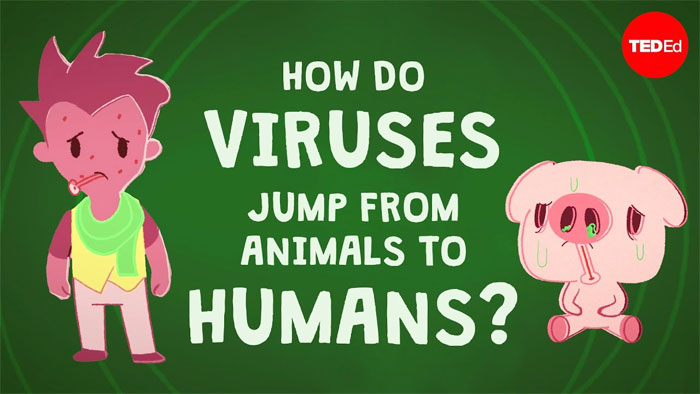How does a virus jump from animal to human?
At the Maryland State Fair in 2017, farmers announced that winning pigs showed fever, red eyes and runny nose. But while organizers were concerned about the pigs, the Maryland Department of Health cared about a group of sick people attending the fair . Some pet pigs, others merely move close to the barn, and soon 40 of them are diagnosed with swine flu.
Infected animals usually do not spread to humans. But when it spreads to humans, the viral host movement is capable of causing deadly disease . So, how does one pathogen infect another species and what makes transferring a subject so dangerous?
Virus is an organic parasite that infects almost every living thing. In order to survive and reproduce, they have to go through three stages: contact with susceptible subjects, infection and then replication and transmission to other individuals.

Virus is an organic parasite that infects almost every living thing.
Take human flu for example. First, the flu virus makes contact with the new host, passes through the respiratory tract, which is not very difficult, but to survive in this new body, the virus must infect the host successfully before the immune response. epidemic extermination. To achieve this goal, the virus has evolved unique interactions with each host species.
The human flu virus is covered with protein, which is adapted to bind to receptors on human respiratory cells. Once in the cell, the virus will take other adaptive measures to hijack the host cell's mechanism of division and copy its genome.
Now it just paralyzes or evades the host's immune system until it multiplies enough to infect more cells. At that time, the flu can be transmitted to the next victim by through fluids from the infected body. And just one sneeze is enough to bring the virus to your pets, crops or even your lunch.
Viruses always meet new species and try to infect them. This often fails, mainly because the genome between hosts is so different. For viruses adapted to infect humans, lettuce cells will be an unfamiliar environment, unsuitable for survival.
But the number of viruses circulating in the environment is staggering, all of which are capable of coming into contact with new subjects. And because they multiply rapidly at the millions level, they can quickly generate random mutations. Most mutations are ineffective or even harmful to itself; but a small percentage of mutations can make it possible for the pathogen to infect new species. The probability of success increases with time, or if a new species is closely related to the virus.
For viruses adapted to other mammals, human infection will require only a few lucky mutations. If a virus has adapted to chimpanzees, the species that is genetically closest to us, it hardly needs any changes. However, time and genomic uniformity are still not enough to make a successful host transition.

Through many processes of transmission, transmission, viruses become much more dangerous.
Some viruses are equipped to easily penetrate new host cells, but cannot bypass the immune system. Some other viruses may be more difficult to transmit to new hosts, however, when the host moves to the infectious stage, the virus becomes much more dangerous.
Now, pathogens that are proliferating in the host are more likely to mutate into a virus, thereby increasing the likelihood of an outbreak. Virologists are constantly looking at mutations that make viruses adapt to flu-like shifts. However, predicting the possibility of an outbreak is a major challenge.
We are just beginning to explore these diverse viruses. Researchers are constantly exploring the biological aspect of pathogens to rapidly develop vaccines and develop policies to prevent outbreaks.
- MERS virus has been transmitted from animals to humans
- Detecting new viruses in human gut
- HIV virus is no longer as dangerous as before
- Successfully created the tiny robot can jump 10 times the height of the body
- For the first time, the H1N1 virus is resistant to human-to-human transmission
- The first time to 'wipe out' the HIV virus from human cells
- Flu viruses can jump up to 2 meters away
- Detecting the 'brother' virus strain of hepatitis C virus
- The 'wand' detects the virus that transmits diseases to humans and animals
- Further detection of new EMC virus causes pneumonia
- Amazing discovery: Zika virus can live in human eyes
- Check out the most dangerous viruses on the planet
 Why do potatoes have eyes?
Why do potatoes have eyes? 'Tragedy' the world's largest carnivorous life: Death becomes ... public toilet
'Tragedy' the world's largest carnivorous life: Death becomes ... public toilet Tomatoes were once considered 'poisonous' for 200 years
Tomatoes were once considered 'poisonous' for 200 years Detecting microscopic parasites on human face
Detecting microscopic parasites on human face